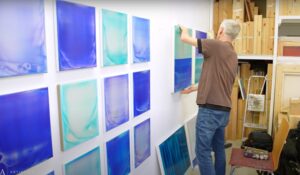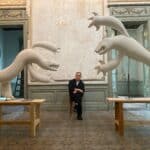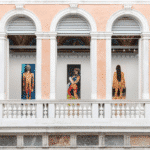Since this summer, the Daiouji temple in Japan boasts a sculpture by artist Hachiro Kanno: three basic geometric figures (circle, triangle and square) suspended in front of a curtain of metallic vines. Installed on a permanent basis in the grounds of this temple founded in 1404, 150 kilometers north of Tokyo, this piece in iron and steel is a part of the artist’s idea of ‘Permanescence”. Hachiro Kanno very kindly accepted to reply to a few questions about this unique creation.

Permanescence (iron & steel, 700 x 800 x 80 cm), August 2014. Photo: Jean-Claude Garnier
What is the name and the significance of this sculpture?
It is called “Permanescence”, which I would define as a succession of life’s essential moments, eternally repeated throughout the course of time. My friends sometimes make fun of me : “Here we go the Japanese are introducing new words into our language… what next!?” But I didn’t do it on purpose! I was simply grappling for the word to describe what I had in my mind. One single word. A neologism? That would be far too little to express my gratitude to France for all she has done for me.
This theme of ‘Permanescence” might be linked to my previous period: Full is empty, empty is full (shiki soku zeï Ku – Ku soku Zeï Shiki,) which is a zen maxim. “Is” and not “and”! The former of which the meaning needs to be discovered and is necessary to be able to one day reach the “satori” (revelation). The latter means purely what it says. This period has followed on from the one I called “The Elements”, symbolized by the circle (water), the triangle (fire) and the square (earth). As a good Japanese man I am first a Shintoist then a Buddhist (mahayana) and finally agnostic. In Japan this is possible. Empty and Full? My next period? Why not “Emptiness and Fullness”?!
How did this project come about?
It is the fruit of a meeting back in the early 1980s, with the reverend (Abbey Father? Prior? “Head Monk”!?) KURASAWA RO-SHI (“Master elder”) during a course on zen for which I had brought together all my students from Happokaï-France and Happokaï-Japan* for a week. Thirty years later therefore, wishing to express my gratitude to the reverend, I suggested the creation of this work. His response :
– Imagine that, I was thinking of putting something of a contemporary nature somewhere, obviously in the spirit of the place. Did you say “Permanescence”? Your proposition is a sign…
To have been able to, as small as it may be, bring (delicate juxtaposition of different styles) a contemporary note to this holy sanctuary is a complete honour for me.
Did you have any particular constraints with this work?
Constraints during its creation? Working with iron, something I knew practically nothing about, and the loathsome weather during its entire edification… The sun only coming out for the inauguration! Another sign!?
Is this a creation of which you are particularly proud?
Proud of my work? I wouldn’t say that. I am the 8th child of a Shinto priest and well known calligrapher, who sadly passed on in 2005 at the age of 105. He was a father, grandfather and great grandfather of artists, themselves parents, or grandparents of still more artists! For starters my eldest brother KEIUN KANNO, founder of the KEÏ YU KAÏ school, who gave up at a very early age the title of future head of the family to solely concentrate on calligraphy. I am particularly proud of them all. Getting back to my father, in seventy years I heard him pass comment about my work three times: “It’s good.” That’s all. On these occasions, yes, I was quite proud of myself.
Now, it’s enough to hope that others, thanks to questions that my sculpture will perhaps make them ask themselves, are going to close in on the famous “satori”. Maybe they’ll get there before me. Probably…
Proud? No, just happy. Happy in the knowledge of hearing my father say: ” It’s good…”
* School founded in Japan at the end of the 1970s

The work during construction. Photo: Jean-Claude Garnier





